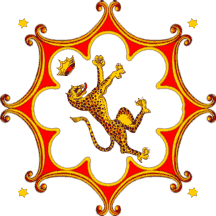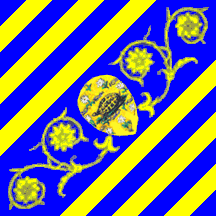
image by Andre' Serranho

Last modified: 2013-11-20 by rob raeside
Keywords: italy | siena | palio | tuscany |
Links: FOTW homepage |
search |
disclaimer and copyright |
write us |
mirrors
See also:

image from <www.radicedidue.com>,
located by Dov Gutterman, 30 July 2002
Note: Although the Republic of Siena is long gone, after being
conquered by Florence during the Medici period, its flag is still
flown, along with the City and People ones, from the main Gates,
in special days, such as the week of the world famous Palio, as
shown under. Thus it is not presented as an historical flag.
Andre' Serranho
Here is an overview about the flags of the Republic of Siena (Italy, 14th century) shown on a medieval fresco painting: The fresco painting "Guidoriccio da Fogliano" by Simone Martini (1284-1344) (see: <www.cisv.it>) was painted in 1328 in Palazzo Publico, the seat of the government of the Republic of Siena [1, 2]. It is named after its central character, a condottiere (commander of the mercenary army) who successfully waged a war for the Republic of Siena [3]. The condottiere is shown on the horse, making rounds of the siege of a city. In the camps of his troops and on the fortification they built, there are many flags of Siena, all based on its coat of arms - per fesse argent and sable - but with colours arranged vertically (there are also several shields of arms, with correct blazon).

image by Tomislav Todorovic and Mladen Mijatov,
29 April 2006
The largest - and probably the most important - of these flags is a swallow-tailed white-black bicolour, flown from a tower of the fortification built for the siege, to the right of Da Fogliano. Several small copies of this flag are flown in the camps to the right of the fortification and another one beneath the besieged city, to the left of Da Fogliano.

image by Tomislav Todorovic and Mladen Mijatov,
29 April 2006
Another bicolour is a gonfanon with four rectangular tongues. Its several copies are flown in the camp in the bottom right corner of the painting and another small one beneath the besieged city, close to the legs of Da Fogliano's horse (in fact, far behind it, as the condottiere is observing the siege from the distance).

image by Tomislav Todorovic and Mladen Mijatov,
29 April 2006
The third bicolour, flown in the camps to the right of the fortification, is a gonfanon with three tongues. It is sometimes charged with a horizontal crossbow, partly (half of the buttstock) on the black and partly on the white. It was not possible to determine its exact colour (red, gold or proper) from the available reproduction of the painting [1], but as it does not always appear on this flag, it is clearly not a compulsory charge, so it is not shown here.

image by Tomislav Todorovic and Mladen Mijatov,
29 April 2006
Another two flags should be described as black flags charged with a white stripe along the hoist, rather than the bicolours, as the black field is much larger than the white one. The first of these is a simple rectangular flag, the white stripe occupying about a third of its length. Its several copies are flown in the camps to the right of the fortification. Just like the previously described flag, it is sometimes charged with the crossbow, which is not shown here for the same reasons.

image by Tomislav Todorovic and Mladen Mijatov,
29 April 2006
Lastly, a long gonfanon with three tongues, black with the white stripe along the hoist, is flown in the camp in the bottom right corner of the painting.
The conclusions which can be drawn from this painting are that the flag of the Republic of Siena did not have a fixed shape and that additional charges, like the said crossbow, may have been added to it, perhaps to distinguish some military units from the others.
Sources:
[1] Piskel, Djina: Ops<ta istorija umetnosti, vol. 2 Belgrade:
Vuk Karadz<ic', 1969 Original title: Gina Pischel,
"Storia Universale dell' Arte", vol. 2 (c) 1966 Arnoldo
Mondadori - CEAM, Milano
[2] Istorija slikarstva - od pec'inskog do apstraktnog Belgrade:
Nolit, 1967 Original title: Histoire illustre'e de la peinture -
de l'art rupestre a` l'art abstrait Paris: Fernand Hazan
E'diteur, 1961
[3] Wikipedia page about the painting "Guidoriccio da
Fogliano" (in Italian): <it.wikipedia.org>.
Tomislav Todorovic, 29 April 2006
Take a look at <civetta.sienanet.it>.
The Palio is explained, and all the flags are illustrated.
T.F. Mills
I got Siena Palio images from a postcard series copyright ca.
1955. The flags from the postcards are the main standards of the
contrade (districts). These are not the throwing versions,
which appear to be much less elaborate. There is also some
evidence that there is no fixed pattern for these flags, and that
they may evolve with the fashions of the times.
T.F. Mills 24 July 1999
This is the most complete site about Palio, Contrade....many
images and flags at <www.ilpaliodisiena.com>.
Alex Baldi , Le Muse Multimediali , 28 March 2000
There are 17 family-districts (contrade) in Siena. You
can see their flags at <www.comune.siena.it>,
click on the IL PALIO box, click on the Le 17 Contrade link,
click on the clickable map.
T.F. Mills, 14 November 2000 and Ole Andersen,
23 March 2001
Having seen many images of the Palio over the decades, I think
it is safe to say there is no "sealed pattern" for
these flags, and they follow the ancient custom of "heraldic
license" where details are not prescribed.
There is also a big difference between these large flags carried
by the standard bearer of each contrada, and the smaller throwing
flags. The latter tend to be of much simpler design, and
they also seem to vary over the years. The constants would
appear to be the major colours and the principal motif.
T.F. Mills, 23 March 2001
I was asked by Jorge Candeias: is there an adecuate
translation in english of "contrada"?
I checked this out yersterday and my dictionary reports
'district', even though it suggests using 'contrada' when
relating to those of Siena. To the best of my knowledge, Palio
roughly translates as 'tournament'. I think the reason is that
Siena dues much of its fame to those 'contrade', as much as
Venice to canals, which are usually translated like that and not
like 'channels' or 'rivers', even though they are actually such
things.
Manuel Giorgini, 14 November 2001
The "contrade" are the quarters of the city that try
to win a flag (il palio) on July 2nd for the first time and on 15
August 15th, for the second time. The race is an horse race on
the main place of the city. Is a medieval race with the people
dressed with medieval costumes. If you want it's possible to have
more information in the site of the town <www.comune.siena.it>.
The names of the "contrade" are:
Torre (Tower)
Bruco (Caterpillar)
Chiocciola (Snail)
Istrice (Porcupine)
Civetta (Owl)
Drago (Dragon) - see photo
of flag at <www.italianfood.about.com>.
Giraffa (Giraffe)
Leocorno (a imaginary
animal vith the body of horse and a horn on the front)
Lupa (Wolf female)
Montone (Ram)
Nicchio (Shell)
Oca (Goose)
Onda (Wave)
Pantera (Panther) - see
below
Selva (Woods, Forest)
Tartuca (Turtle) - see
below
Aquila (Eagle)
Bruno Fracasso, 18 December 2001
Mills say that "[...] There is also some evidence that
there is no fixed pattern for these flags, and that they may
evolve with the fashions of the times.[...]". Now this is
not more true because the Consorzio per la Tutela del Palio di
Siena has internationally registered the Marks and flags of each
Contrada. So there is a difference between ORIGINAL Palio di
Siena flags and IMITATIONS: for every informations and images
these two links are offficial: <www.ctps.it>
(click on ENTRA, then on "AREA MACRCHIO" then on
"I Marchi Registrati" you will have all the ORIGINAL
and OFFICIAL 17 Contradas registered Marks of flags).
Contrada has not a real english translation, you can compare to a
district (that in italian we say QUARTIERE), but it has not a
translation, tha Consorzio per la Tutela del Palio di Siena uses
it also in english: singular: CONTRADA, plurial: CONTRADAS. Also
in Italy the name Contrada is unique for those cities that have a
Palio (there are hundreds of Palio in Italy, above all in the
Centre, like Ascoli, etc.). The district in fact is a concept
relating to the urbanization, normally you divide cities in
different district with different services accesses; while if you
take a look of Contradas division it has nothing relating to the
city shape or services, it has an historical and familiar origin.
Consider that in the 1200 there were about 50 different Contradas
in Siena.
Actually biggest images of Palio di Siena are on our website <www.flagsonline.it>
(Click on each contrada to enlarge the image).
Paolo. 11 May 2005
The "contrada" (plural "contrade") is one
of the 17 (currently and since 18th century) inner city districts
(just within the ancient walls). In (fairly old-fashioned)
Italian it's the equivalent of "piece of land". Their
origin is not absolutely certain but the most acknowledge
interpretation is that they derive from medieval
"confraternite", i.e. private associations of citizens
dedicated mainly to social scopes like assisting orphans or
widows or homeless, etc. Those associations
"overlapped" with the military organization of the
city, where each district had the responsibility to ward a
section of the walls or provide a certain amount and type of
armed men. By the way, do not look at a map of Siena trying to
understand the relationship between the apparent shape of a
contrada territory and other functions, as the city territory is
so complicated by steep up and downs that a "flat" map
will never correctly represent it.
The name "palio" (plural "palii") comes from
the Latin "pallium" which means "broad piece of
precious cloth" and refers to the prize (a long, broad piece
of precious cloth) which was awarded to the contrada winning
ancient contests. Those contests were not originally horse races,
they were "shows" or "processions" made in
honour of a saint or of an illustrious person visiting Siena. The
contrada performing the best show was awarded the
"pallium".
The Palio of Siena is NOT a medieval rievocation, it's the REAL
thing! In fact, the Palio in Siena NEVER went "out of
fashion" during the centuries (differently from all other
palii which have been resumed for touristic reasons).
Finally, about the flags. There's now fixed shape or design for
the flags of the contrade. Only the colours and the symbol are
fixed. Contrade periodically "refresh" their flags with
a new design. The Consorzio di Tutela del Palio is an
almost-commercial institution, barely recognized by true senese
people. Any flag you could just buy in Siena is, by definition,
NOT an original one, as flags are considered sacred by the people
and they would NEVER sell the TRUE flags. In recent years, some
tourists have stolen flags from the house fronts, maybe thinking
they were just nicking an "advertising gadget". Please
consider that this is, to siena people, like stealing a sacred
ornament in a church! A simple as that!
Carlo Duroni, 25 May 2006
Three older flags (photos 1,
2, 3) of Sienese contrade
(approx. 1957) are for sale at the Italian
Ebay.
Marcus Schmöger, 8 June 2006
Several historical postcards were on sale at Italian Ebay, all of them showing
variants of the respective Siena contrade flags: Selva. Tartuca and Pantera. A more modern
(1963?) postcard as well.
Marcus Schmöger, 1 November 2006
Currently at the Italian Ebay
there several flags of the contrade of Siena such as here
and here.
Marcus Schmöger, 12 July 2007

image by Marcus Schmöger, 23 August 2001

detail
image by Marcus Schmöger, 23 August 2001
Recently a friend of mine brought me a flag he bought in
Siena. It is obviously one of the flags of the Contrade in Siena,
namely the Contrade della Pantera. It differs from the design
shown on the website of Siena, though.
However, there were already reports, that there are always quite
a lot of variations from the basic design.
Marcus Schmöger, 23 August 2001
The Contrada della Pantera flag is not correct: as you can
verify on the official Contrada website: <www.contradadellapantera.it>
the Coat of Arms is in the upper-left corner, the image Moreover
the pantheress is not correct: crown is closer. Finally also the
flag background is not correct. Also in the Comune di Siena <www.comune.siena.it>
you have the real flag and not this one.
Paolo. 11 May 2005

image by António Martins-Tuválkin, 27 March 2005
The Contrada della Tartuca (Turtle District) palio
flag - As all the others, it is square, with diagonal ascending
stripes (from bottom hoist to top fly) in blue and yellow. The
middle stripe (a blue one) is about five times wider and shows
the district Coat of Arms shield flanked by symmetrical flower
branch ornaments; the other stripes are six to each side (the
last ones, also blue, show as triangles, at top hoist and bottom
fly). The Coat of Arms is a turtle proper on a ground or
semeé of daisies proper.
António Martins-Tuválkin, 27 March 2005
This image is not the original Tartuca flag but it is a flag
sold as Tartuca contrada. The original Tartuca image is at <www.ctps.it>.
Differences are in colours and designs (shapes), for example
Tartuca you sent has a completely different turtle: the original
is a green turtle, quite spherical, with the head looking above.
Turtle you sent was completely different. Also turtle background
is quite different "Margherita" (white flowers name in
Italian) in this image are enormous, original one shows flowers
really different.
Paolo, 29 March and 4 April 2005
Here is the flag of AC
Siena, the main soccer team of the town of Siena, in Tuscany from
<www.acsiena.it>.
Paolo Montanelli, 7 August 2003